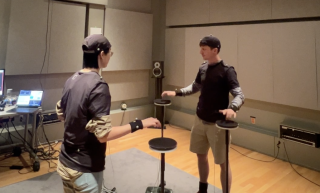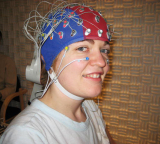


We use several measurement techniques (tabs on left margin): motion capture, electroencephalography, audio recording, and eyetracking techniques. Expert and novice performers are recorded with computer-monitored musical instruments while their joint and limb movements are recorded with motion capture techniques.
Electrophysiological responses to speech and music signals are recorded with a 64-channel electroencephalography (EEG) unit that captures event-related potential recordings under controlled acoustic conditions.
High-quality audio recordings are made during monologues and dialogues (conversation) that allow us to study speech prosody and working memory for auditory signals under naturalistic conditions.
Eye-movement trackers, mounted on glasses frames, capture directions of eye gaze in musicians and speakers under natural lighting conditions.